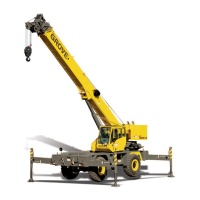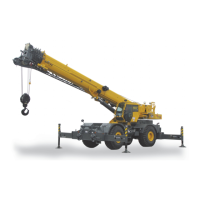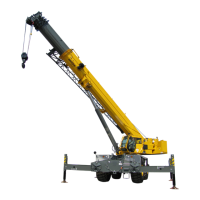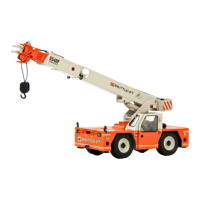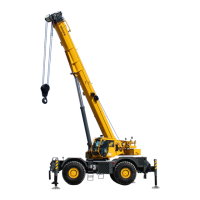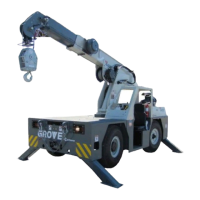Published 4-20-2015, Control # 502-01 5-1
RT540E SERVICE MANUAL HOIST AND COUNTERWEIGHT
SECTION 5
HOIST AND COUNTERWEIGHT
SECTION CONTENTS
Description . . . . . . . . . . . . . . . . . . . . . . . . . . . . . . . 5-1
Theory of Operation . . . . . . . . . . . . . . . . . . . . . . . . 5-1
Maintenance . . . . . . . . . . . . . . . . . . . . . . . . . . . . . . 5-2
Warm-up Procedure . . . . . . . . . . . . . . . . . . . . . . . 5-2
Removal . . . . . . . . . . . . . . . . . . . . . . . . . . . . . . . . 5-2
Installation. . . . . . . . . . . . . . . . . . . . . . . . . . . . . . . 5-3
Functional Check . . . . . . . . . . . . . . . . . . . . . . . . . 5-3
Servicing . . . . . . . . . . . . . . . . . . . . . . . . . . . . . . . . 5-3
hoist maintenance and inspection . . . . . . . . . . . . 5-4
Usage and Inspection . . . . . . . . . . . . . . . . . . . . . . 5-4
Pre-Use or Daily Inspection . . . . . . . . . . . . . . . . . 5-5
Quarterly Inspection (every three months) . . . . . . 5-5
Semi-Annual Inspections (every six months) . . . . 5-5
Annual Inspection . . . . . . . . . . . . . . . . . . . . . . . . . 5-5
PREVENTIVE MAINTENANCE AND OIL
SAMPLING. . . . . . . . . . . . . . . . . . . . . . . . . . . . . . . . 5-5
Oil Change . . . . . . . . . . . . . . . . . . . . . . . . . . . . . . 5-5
Gear Oil Sampling and Analysis . . . . . . . . . . . . . . 5-5
BRAKE TEST PROCEDURE FOR HP15C-17G,
HO30A-19G, HP35-26G HOISTS . . . . . . . . . . . . . . . 5-6
Brake Test Procedure (To be performed with no load
on the hoist). . . . . . . . . . . . . . . . . . . . . . . . . . . . . . 5-6
Hoist to Boom Alignment . . . . . . . . . . . . . . . . . . . . 5-7
Preparation . . . . . . . . . . . . . . . . . . . . . . . . . . . . . . 5-7
Tools Required . . . . . . . . . . . . . . . . . . . . . . . . . . . 5-7
Procedure . . . . . . . . . . . . . . . . . . . . . . . . . . . . . . . 5-7
Piston Motor and Control Valve. . . . . . . . . . . . . . . 5-8
Description. . . . . . . . . . . . . . . . . . . . . . . . . . . . . . . 5-8
Maintenance . . . . . . . . . . . . . . . . . . . . . . . . . . . . . 5-8
Idler Drum and Cable Follower. . . . . . . . . . . . . . . . 5-9
Description. . . . . . . . . . . . . . . . . . . . . . . . . . . . . . . 5-9
Maintenance . . . . . . . . . . . . . . . . . . . . . . . . . . . . . 5-9
Hoist Drum Rotation Indicator System . . . . . . . . 5-11
Description. . . . . . . . . . . . . . . . . . . . . . . . . . . . . . 5-11
Maintenance . . . . . . . . . . . . . . . . . . . . . . . . . . . . 5-11
Counterweight Removal . . . . . . . . . . . . . . . . . . . . 5-13
DESCRIPTION
One hoist is available; the HP15C-17G (Figure 5-1). The
hoist incorporates one dual displacement piston motor which
drives a reduction unit within the hoist. The hoist utilizes
planetary reduction with a multi-disc automatic brake that is
spring applied and hydraulically released. An overrunning
clutch allows the hoist to be raised without releasing the
brake while at the same time holding the load until there is
sufficient pressure to release the brake when hoisting down.
The hoist motor controls both speed and torque of the hoist.
There are two modes in which the hoist operates. One mode
is high speed. The pilot solenoid valve shifts the selector
spool on the motor to provide minimum motor displacement.
This gives high line speed and low torque.
The second mode is low speed. The pilot solenoid valve
shifts the selector spool on the motor to provide maximum
motor displacement. This gives low line speeds and high
torque.
THEORY OF OPERATION
The hoist assembly is controlled by hydraulic remote
controllers located in the cab. When the control lever in the
cab is moved from neutral, it causes the hoist section of the
directional control valve to shift the valve spool to route
hydraulic flow to the hoist motor control valve. The hoist
motor control valve is used to stop or slow the hoist when the
load is trying to drive the hoist down too quickly. The motor
control valve is piloted open by the hoist down pressure. If
the load lowers faster than the flow of oil in the hoist down
line, the pilot pressure decreases and the motor control valve
partially closes to restrict the oil leaving the motor until a
balance occurs. This results in the load lowering at a uniform
speed based on the position of the hoist control lever.
During stopping, when the hoist down flow ceases, the pilot
pressure holding the motor control valve open decays to
zero and the motor control valve spool closes, thus blocking
all flow of oil out of the hoist motor. This same pressure
decay allows the spring applied pressure released hoist
brake to apply when the load is fully stopped. This brake acts
as a “parking brake” and holds the load in the stopped
position.
Reference Only

